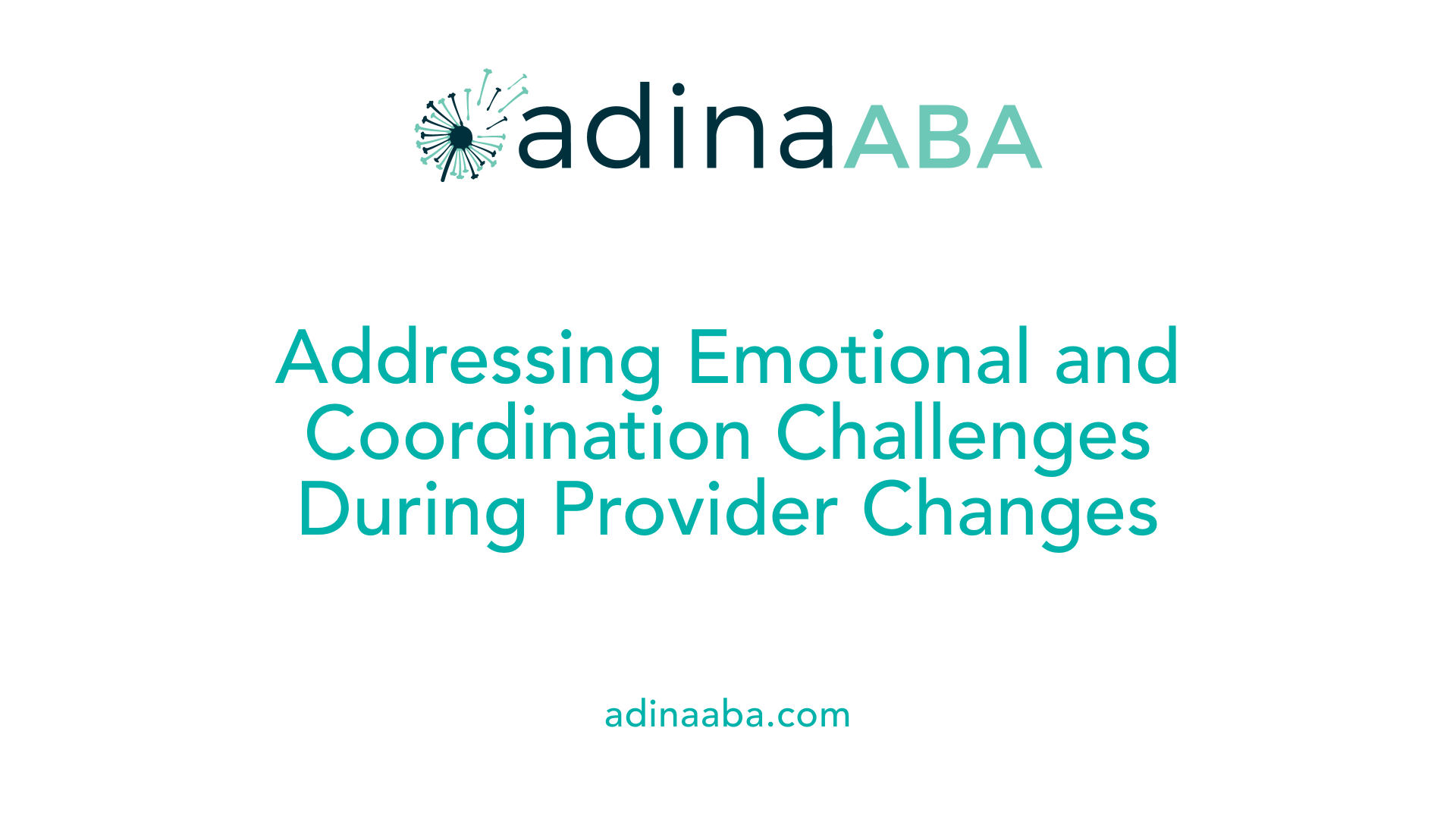Supporting transitions between therapy providers

Navigating the Complexities of Therapy Provider Changes
Transitions between therapy providers are critical junctures that require meticulous planning and communication to ensure continuous, effective care. Whether shifting from pediatric to adult services, moving between mental health specialists, or adapting to new healthcare environments, supporting these transitions is vital for maintaining therapeutic progress and patient trust. This article explores the essential frameworks, best practices, innovative strategies, and organizational efforts that underpin successful transitions across healthcare and mental health settings.
Understanding the Role of Effective Communication in Healthcare Transitions
What is the role of effective communication in healthcare transitions?
Effective communication is vital during healthcare transitions because it ensures that critical information about the patient's care, preferences, and history is accurately conveyed between providers, patients, and families. This clarity helps to prevent errors such as medication mismatches, duplicated tests, or missed follow-up care.
Structured handoff methods, like ISBAR (Identify, Situation, Background, Assessment, Recommendation), provide a clear framework for sharing patient information systematically. These techniques help to standardize exchanges, making sure essential details are not overlooked.
Standardized documentation tools, including checklists and electronic health records (EHRs), further support this process by providing consistent, accessible, and comprehensive data that can be referenced during each transition.
Engaging patients and their families early and actively in the transition process encourages shared decision-making. This involvement builds trust, aligns care with patient preferences, and can reduce feelings of uncertainty or anxiety.
Organizational strategies—such as staff training in communication skills, implementing robust health IT systems, and developing policies for information exchange—are crucial to fostering a culture of transparency and coordination.
By prioritizing effective communication, healthcare systems can reduce adverse events, improve care continuity, shorten hospital stay durations, and enhance overall patient satisfaction. Ultimately, good communication is the backbone of safe and patient-centered healthcare transitions.
Frameworks and Guidelines Supporting Therapy Transitions
What frameworks or guidelines exist for supporting therapy transitions in healthcare?
Supporting smooth transitions in healthcare and therapy relies on well-established frameworks and guidelines that provide structured, patient-centered approaches. One prominent model is the 'Care Transitions Framework,' which organizes the critical factors influencing successful transitions. This framework considers intervention characteristics, organizational structures, and the roles of all involved stakeholders. It emphasizes standards such as medication reconciliation, comprehensive assessments, and effective communication to prevent gaps in care.
Another widely adopted model is the Six Core Elements of Health Care Transition™. This structured process focuses on planning, assessing readiness, and ensuring proper transfer of care, particularly for youth moving from pediatric to adult healthcare services. These core elements promote early planning, involving youth and families actively, and preparing patients for independent management of their health.
Medical organizations like the American Academy of Pediatrics (AAP), American College of Physicians (ACP), and American Academy of Family Physicians (AAFP) also provide specific guidelines. They recommend initiating transition planning early—around age 12—and collaborating with youth and families to develop individualized transition plans. Emphasis is placed on addressing legal, cultural, and social factors that might affect the transition.
Overall, these frameworks underscore key principles such as effective communication, continuity of care, stakeholder engagement, and tailored intervention strategies. They aim to minimize disruptions, improve patient outcomes, and foster a seamless experience for both patients and providers during transitions.
Supporting a Smooth Transition Between Therapy Providers
Effective support during transitions between therapy providers hinges on a combination of evidence-based models, collaborative engagement, and comprehensive information sharing. Implementing structured frameworks such as the Care Transition Intervention (CTI), Brief Organizational Supportive Techniques (BOOST), or Transition Care Model (TCM) can greatly improve continuity of care. These approaches emphasize detailed planning, medication management, and ongoing follow-up to ensure patients do not fall through the cracks.
Engaging patients and their families early and throughout the process is crucial. Providing education about what to expect, involving them in shared decision-making, and validating their concerns foster a sense of empowerment and readiness. This active participation helps reduce anxiety and enhances adherence to treatment plans.
A thorough transfer of information between providers minimizes risks associated with miscommunication. Utilizing standardized tools, such as the Got Transition resources, guides clinicians through assessing patient readiness, developing transition policies, and ensuring proper documentation. These tools facilitate consistent and complete sharing of medical history, treatment goals, and patient preferences.
Incorporating social workers or care coordinators into the process adds another layer of support. They assist in addressing insurance issues, locating suitable new providers, and maintaining patient engagement. Their involvement ensures that logistics are managed smoothly, allowing clinicians to focus on clinical aspects of patient care.
Overall, a coordinated, informed, and patient-centered approach—bolstered by specialized tools and dedicated personnel—creates a seamless transition experience that maintains therapeutic continuity and promotes better health outcomes.
For further guidance, healthcare providers can review best practices for therapy provider transition support through reputable sources and clinical guidelines, ensuring they adopt the most effective strategies for their setting.
Strategies to Facilitate Transition from Pediatric to Adult Healthcare
What strategies can facilitate effective transitions from pediatric to adult healthcare for young patients?
Successfully navigating the shift from pediatric to adult health services requires concerted planning and collaboration. Implementing early, individualized transition plans starting around ages 12 to 14 helps set a foundation for independence and self-management.
Educational initiatives tailored to young patients and their families are vital. Teaching self-care skills, health system navigation, and decision-making prepares them for future autonomy. This process involves gradual education that empowers youths to understand their conditions and advocate for themselves.
Active involvement of both youth and families in developing comprehensive transition plans ensures everyone shares a clear understanding of goals and expectations. This collaborative approach fosters trust and readiness, reducing anxiety associated with change.
Effective communication between pediatric and adult healthcare providers is crucial. Sharing detailed medical summaries, care plans, and transition documents helps ensure continuity of care and minimizes information gaps. Tools and frameworks, such as those provided by Got Transition's Six Core Elements, assist clinicians and families in establishing structured, patient-centered processes tailored to individual needs.
Addressing developmental and resource barriers—like limited access to specialized care or support services—is essential. Policies that promote provider training, mental health support, and family engagement can help overcome these challenges.
In summary, early planning, education, shared resources, and coordinated care form the backbone of successful transition strategies, ultimately improving health outcomes for young people moving into adult healthcare systems.
Best Practices for Maintaining Continuity of Care During Provider Changes

What are best practices for ensuring continuity of care during therapy provider changes?
Maintaining seamless care during transitions between healthcare providers is vital to prevent gaps that could impact patient outcomes. One of the most effective approaches is implementing structured handovers. This includes detailed documentation that summarizes the patient’s treatment history, current status, and future plans.
Medication reconciliation plays a crucial role in this process. It involves creating an accurate and up-to-date list of all medications the patient is taking, comparing it against new prescriptions, and resolving any discrepancies. This reduces the risk of medication errors and adverse events.
Engaging and educating the patient is equally important. Patients should be informed about their medications, treatment goals, and what to expect during the transition. Encouraging active participation helps improve adherence and reduces anxiety.
The use of electronic health records (EHRs) and other digital tools greatly enhances the quality and speed of information sharing. Electronic transfer of medical summaries, lab results, and medication lists ensures that providers have relevant information at hand.
Follow-up activities, especially for high-risk patients, are essential. Timely checks—such as medication reconciliation within one week of discharge—help identify and address any issues early on. Incorporating collaborative case management involving hospital teams, primary care, and community organizations further supports effective care continuity.
Ultimately, combining organized communication, patient involvement, and technology use fosters safer and more effective transitions in care. These strategies reduce errors, improve treatment adherence, and enhance patient satisfaction during provider changes, supporting continuous, high-quality care.
Supporting System-Level and Policy Initiatives for Seamless Transitions
 States across the country are taking proactive steps to improve the way patients transition between care providers, especially in the context of mental health, addiction, and chronic illness care. Public policies and innovative programs are essential to bridge gaps, reduce disruptions, and promote continuous, person-centered care.
States across the country are taking proactive steps to improve the way patients transition between care providers, especially in the context of mental health, addiction, and chronic illness care. Public policies and innovative programs are essential to bridge gaps, reduce disruptions, and promote continuous, person-centered care.
One approach involves establishing dedicated funding models and programs. For example, California offers up to $5,000 for community transition services to assist residents moving from nursing facilities or hospitals into the community. Similarly, Arizona’s Medicaid demonstration includes housing supports for long-term care residents who are medically able to live independently. These financial aids reduce barriers and facilitate smooth transitions, addressing social determinants of health.
Innovative care delivery models, such as hospital-at-home programs, are also gaining momentum. These programs, supported by state legislation in North and South Carolina, utilize interdisciplinary teams to provide hospital-level care in the patient’s home. Such models have been linked with reduced costs, fewer readmissions, and better patient outcomes.
Effective care management is vital to support complex transitions. States are promoting the use of interdisciplinary teams, cross-coverage protocols, and dedicated transition case managers. These strategies foster comprehensive planning, promote communication, and ensure continuity during care shifts. Incorporating electronic health records (EHRs) and telehealth solutions enhances real-time data sharing, though efforts continue to overcome interoperability challenges.
Addressing workforce shortages and policy barriers remains a significant focus. States are investing in professional training, advocacy, and workforce support programs. For example, telehealth policies have been expanded to include remote patient monitoring and store-and-forward consultations, broadening access and reducing provider shortages.
Navigation services also play a central role. These trained personnel help youth and families navigate mental health and addiction systems, simplifying pathway complexities and ensuring personalized, continuous support. They advocate, provide credible information, and foster system collaboration, which significantly improves engagement and reduces crises.
Overall, systemic and policy-level efforts are vital in creating an environment where transitions are safer, more efficient, and centered around patient needs. Continued innovation, strategic funding, and workforce development will be necessary to sustain these advances and address ongoing challenges in healthcare transitions.
Challenges and Solutions in Therapy Provider Transitions

What challenges typically arise during therapy provider transitions, and how can they be addressed?
Switching therapy providers can be complex and often presents several obstacles. Among the most common are communication gaps, where vital patient information fails to transfer smoothly between providers. This can lead to gaps in treatment, medication errors, or duplicated efforts.
Patients themselves may experience significant emotional distress. The fear of losing the trust and rapport built with their previous therapist can cause anxiety and resistance to the transition. Additionally, coordination issues among healthcare teams and varying treatment approaches can complicate the process.
To navigate these challenges effectively, implementing structured protocols is crucial. This includes creating comprehensive transfer forms, detailed case summaries, and clear communication pathways such as direct contact between outgoing and incoming clinicians.
Building trust is fundamental. Clinicians should actively listen to patients' concerns, validate their feelings, and explain each step of the transition process. Providing transparent information and empathetic support helps ease fears and reassures patients.
Long-term support strategies also play a valuable role. Follow-up appointments, support groups, or regular check-ins after the transition can maintain emotional stability. Maintaining ongoing communication between clinicians ensures continuity of care, helps address emerging issues, and reinforces the patient’s confidence in their new provider.
Enhancing the Future of Therapy Transitions
Supporting smooth transitions between therapy providers is essential for maintaining therapeutic progress, ensuring safety, and fostering trust. By adopting evidence-based frameworks, leveraging effective communication, implementing organizational strategies, and promoting systemic policies, healthcare systems can better serve patients during these crucial periods. Continuous education for providers, integration of innovative tools like telehealth and health IT, and dedicated support services such as navigation programs all contribute to more resilient, patient-centered transition processes. As healthcare continues to evolve, prioritizing the refinement of transition practices will lead to improved outcomes and higher satisfaction for patients and clinicians alike.
References
- The Role of Counseling in Navigating Life Transitions
- Interventions to Support Transitions in Care Among Patients With ...
- Supporting Patients & Families Through Provider Transitions 7/23/25
- Brief Supporting Transitions of Care
- 7 Steps to Ensure a Smooth Transition to New Therapy Providers
- Health transition tips and resources for healthcare providers
- Supporting the Health Care Transition From Adolescence to ...
More Resources
Expert Clinicians
Get started today ->






